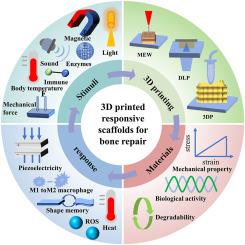Recent progress of 3D printed responsive scaffolds for bone repair: A review
IF 10.2
1区 医学
Q1 ENGINEERING, BIOMEDICAL
引用次数: 0
Abstract
Bone defects are complex in etiology, extensive in scope, and associated with local microenvironmental disruption, leading to issues such as donor site complications, poor biocompatibility, and inadequate functional recovery with traditional treatment methods (e.g., autologous bone transplantation, metal implants). Bone repair scaffolds have garnered widespread attention due to their excellent biomimetic properties and high repair efficiency. With the advantages of personalization, high-precision manufacturing and complex structure forming, 3D printing technology has shown great potential for application in the field of bone restoration. In contrast to conventional bone scaffolds, responsive scaffolds emulate the dynamic environment of the natural extracellular matrix, which can produce controlled effects in responding to stimuli, hence promoting cell multiplication and differentiation and bone regeneration. This review introduces the study of human bone structure and defects, summarizes the 3D printing technologies of preparing bone scaffolds, concludes the characteristics and applicability of different 3D printing technologies, then the applications of light, piezoelectric, temperature, immune, magnetic, and enzyme-responsive scaffolds in the field of bone repair are summarized according to the types of responses of bone scaffolds to various types of stimuli in the human body, and finally the problems faced by responsive scaffolds in the process of clinical translation are pointed out.

3D打印响应性骨修复支架的研究进展
骨缺损病因复杂,范围广泛,并与局部微环境破坏有关,导致供体部位并发症、生物相容性差以及传统治疗方法(如自体骨移植、金属植入物)功能恢复不足等问题。骨修复支架因其优异的仿生性能和较高的修复效率而受到广泛关注。3D打印技术具有个性化、高精度制造和复杂结构成型等优势,在骨修复领域显示出巨大的应用潜力。与传统骨支架相比,响应性支架模拟了天然细胞外基质的动态环境,可以对刺激产生可控的反应,从而促进细胞增殖分化和骨再生。本文介绍了人体骨骼结构和缺陷的研究,总结了3D打印制备骨支架的技术,总结了不同3D打印技术的特点和适用性,然后根据骨支架对人体各种刺激的反应类型,总结了光、压电、温度、免疫、磁、酶反应等3D打印技术在骨修复领域的应用。最后指出了反应性支架在临床转化过程中面临的问题。
本文章由计算机程序翻译,如有差异,请以英文原文为准。
求助全文
约1分钟内获得全文
求助全文
来源期刊

Materials Today Bio
Multiple-
CiteScore
8.30
自引率
4.90%
发文量
303
审稿时长
30 days
期刊介绍:
Materials Today Bio is a multidisciplinary journal that specializes in the intersection between biology and materials science, chemistry, physics, engineering, and medicine. It covers various aspects such as the design and assembly of new structures, their interaction with biological systems, functionalization, bioimaging, therapies, and diagnostics in healthcare. The journal aims to showcase the most significant advancements and discoveries in this field. As part of the Materials Today family, Materials Today Bio provides rigorous peer review, quick decision-making, and high visibility for authors. It is indexed in Scopus, PubMed Central, Emerging Sources, Citation Index (ESCI), and Directory of Open Access Journals (DOAJ).
 求助内容:
求助内容: 应助结果提醒方式:
应助结果提醒方式:


